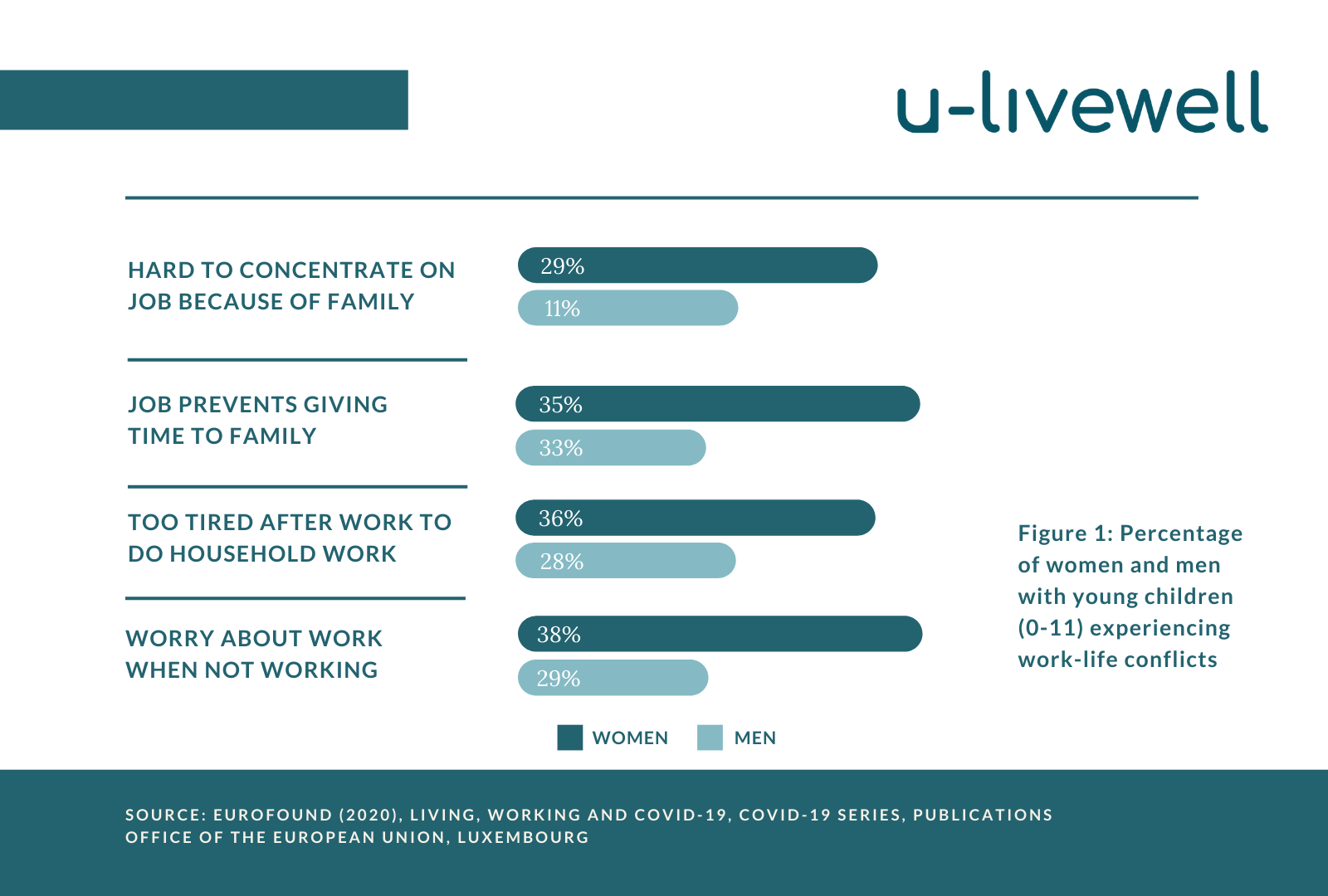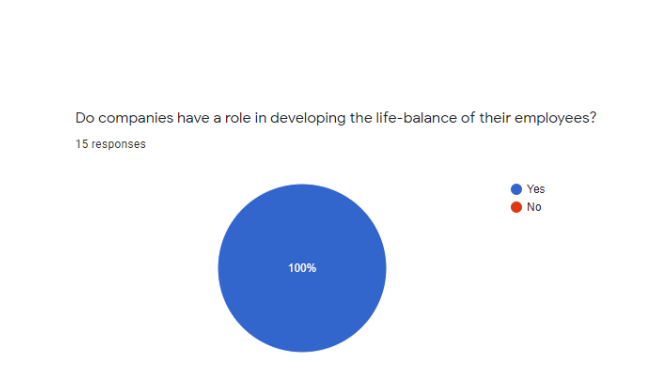Are Companies Responsible For Their Employees’ Life-Balance?
In a 2020 survey by Eurofound, 29% of women and 11% of men stated that it is hard for them to concentrate on their jobs because of family while 35% of women and 33% of men said that jobs prevent them from giving time to family.
The survey also revealed that 36% of women and 28% of men are too tired after work to do household chores.
Probably the most surprising finding is that 38% of women and 29% of men still worry about work even when they’re not working. Overall, the survey revealed that a significant percentage of men and women with young children are experiencing work-life conflicts.
If these problems that concern stress management, time management and resilience building are not addressed, these could happen:
- Employees will experience burnout.
- Employees will be prone to chronic diseases.
- Employees will feel demotivated.
And these will lead to increase in absenteeism and presenteeism rates in organizations.
The Cost of Presenteeism
Presenteeism refers to situations when employees come to work but are unproductive due to many reasons, such as burnout, mental illness, demotivation, no chemistry with the team, conflicts, time management and stress.
Remember that the cost of presenteeism to businesses is almost 10 times higher than that of absenteeism.
Absent workers cost employers around US$150 billion per year, but those who came to work and were not fully productive cost US$1,500 billion per year in the US, based on the BLS data.
In the Middle East, based on the new GCC Insights, the Global Corporate Challenge (GCC) found out that employees were unproductive for 57.5 days each year, and that’s equivalent to almost three working months.

This has led me to thinking: Are companies responsible for their employees’ life-balance?
We have reached out to experts across different sectors worldwide and asked them two questions:
1) Do companies have a role in developing the life-balance of their employees?; and
2) What can companies do to help their employees achieve life-balance?
Flexible working hours, remote work, understanding employees’ individual needs, and allowing time for family and recreational activities are the common recommendations mentioned by our respondents in support of life-balance.
Do companies have a role in developing the life-balance of their employees?
All of the HR experts that we reached out to believe that companies have a role in developing their employees’ life-balance.

Here are some of the highlights in the points and recommendations shared by the HR Experts when asked how companies could help their employees achieve life-balance:
- Providing flexible work options.
- Supporting the wellbeing of employees.
- Having guidelines and principles on how a healthy life-balance should look like.
- Nominating life-balance partners to promote life-balance within the company.
- Creating flexible policies that help achieve life balance, such as flexible working hours, remote working, self sick leave, advanced salary, and entertainment discount extended to friends and family.
- Facilitating awareness sessions on how employees could be productive at work while maintaining their personal lives.
- Enforcing the culture that helps segregate work time from off-work time.
- Encouraging efficient work, not more work. Offering flexible and remote working, giving time to volunteer, and giving access to exercise.
- Not asking employees to sacrifice their personal lives for the sake of their job security or prioritize their livelihood over their family.
- Finding a good way to address the individual needs of employees by taking into account the different life phases of employees. For example, young parents have different challenges than employees without children.
- Ensuring that employees are given the right tools to perform their roles to the best of their ability. This may be in the form of flexible hours, flexibility for working parents, remote work options and setting realistic expectations with clients.
- Building a workplace culture that is motivating and energizing and purpose driven to instill a sense of self-confidence and self-esteem among employees.
- Providing life insurance, along with health insurance. Promoting team-building activities and awareness campaigns; holding team meetings outside the office without discussing work.
- Setting a course of action to change the organization from within. It should be approached holistically and incorporated at every level of the organization. Train employees, provide them with the right tools and initiatives; and empower them to encourage change in behaviour and attitude.
- Making mental, emotional, and physical wellness a priority and not an add-on. Making vacations mandatory on an annual basis to make sure everyone gets their switch-off time.
Here’s our interview with 15 HR experts:
What can companies do to help their employees achieve life-balance?
Focus on productivity and not hours; flexible working, Working remotely; lead by example. — Alexandra Richardt, Global Head of Human Resources, United Initiators GmbH
Education, flexible working, well being support, active promotion of work-life balance — Rachid ‘Ben’ Bengougam, Senior VP HR EMEA, Hilton
Be role models and have guidelines and principles on how a healthy life-balance should look like and most important of all walk the talk. — Tim Shahriar Tabrizi, Serial Entrepreneur, Supply Chain Expert, Former CPO of WSA
First of all, companies should have a willingness for WLB or LB as a LB partner of each employee and should not act like Police State. Exactly like Business Partnering, each company must nominate staff as Life Balance Partners who will propagate LB. — Uday Dongare, Head HR Administration, L&T
Being an expatriate and managing over 50 nationalities in one property is not easy to ensure the Talent is welcome and feeling home.
One thing always stands up to is how to let the talent balance their life. Having fun in the workplace, building relationships among the talent, and create flexible policies are also helping to achieve life balance. For instance, flexible working hours, remote working, self sick leave, advanced salary, and entertainment discount extended to friends and family. — Kheder Osman, Assistant Director of Human Resources at W Abu Dhabi Yas Island
Encourage the flexible working hours, compress working days and long weekends, telework invite family members to workplace, awareness sessions on how to be productive at work while maintaining your personal life. I used to say: prior 2020, we take the pending work from the office to home; after 2020, we take pending work from home to office. — Mahmoud Alabdali, Head of Human Resources, MyClinic
Mainly two things, first, create a company of experience that aims to enjoying life beside work, as in employee welfare programs, second & most importantly is to enforce the culture segregating work time from off work time, i.e. weekend is for rest, week days for work, annual leave is for rest, work days for work, etc. — Hussein El Ashmawi, Group HR Director, Alameda Healthcare Group
Offer flexible and remote working, give time to volunteer, give access to exercise.
Don’t push seniors to retire in order to finally pursue their dreams. By letting seniors work remotely, they can move to their ideal location, travel, and spend more time with their families – while still contributing to your organization’s success.
Encourage Efficient Work – Not More Work, In addition to performance concerns, working long hours has proven to be damaging to employee morale – The Mental Health Foundation reports that when working long hours, 27% of employees feel depressed, 34% feel anxious and 58% feel irritable. — Kamesh Chaganti, Vice President – Human Resources, Zee Entertainment Middle East
In a world where someone’s time is almost equally divided between home and workplace, companies can and must play a vital role in helping their employees achieve a life-balance.
This can be done by first and foremost creating a workplace atmosphere that reflects real life. A place where employees are people who have an actual life happening outside the walls of the office in which emergencies might come up or situations may arise which the employee needs not to apologize or feel bad for.
Staff shouldn’t be made to feel guilty because they had a personal issue which needed them to be away from their working desks for a certain amount of time.
— Maral Baboyan
Second, being in a working environment which doesn’t abuse the employee mentally and emotionally is vital in helping employees lead a balanced life; one in which the person doesn’t go home drained to the point where they are unable to live out their personal lives.
In a nutshell, companies should learn not to ask a person to sacrifice their personal lives for the sake of their job security or prioritize their livelihood over their family. Always keep in mind that when a person is given the flexibility and freedom to comfortably balance out their professional and personal lives is one that will achieve more on all fronts. — Maral Baboyan, Head of HR, Key of Education International School – Qatar
In my point of view, the main task for companies to ensure the life-balance of their employees is to find a good way to address the individual needs of employees.
Taken into account the different life phases of employees, it quickly becomes clear that young parents, for example, have different challenges than employees without children.
The generation models also show that companies must respond flexibly to the different demands and expectations of employees in order to be and remain attractive.
Whereas work typically comes first for baby boomers, the situation is very different for the following generations X and Y. Here, self-fulfillment, purpose and independence are high on the list of priorities regarding working life. Of course, exceptions confirm the rule here as elsewhere.
These different expectations are increasingly coming into conflict as Gen Y is widely entering the labour market. This often leads to conflicts between employees and managers, but also within teams. Not everyone involved always has the necessary understanding for the other´s needs.
Here, as a company, it is important to create appropriate framework conditions so that all employees can relate and conflicts can be avoided.
— Christine Fink
Especially in the more conservative industries, I believe this will be a major challenge for companies in terms of leadership, teamwork and flexibility. Working time regulations, shift models and infrastructures need to be re-thought in order to respond more agilely and flexibly to the needs of employees and at the same time ensure the effectiveness and profitability of the company. — Christine Fink, Head of Human Resources Europe & South America, GF Machining Solutions
With work schedules getting busier than ever before and clients becoming more demanding, the pressure on employees to perform above and beyond expectations is huge.
There is an immense responsibility on forward thinking organisations to ensure a healthy life-balance for all of their employees. Studies have shown that balanced employees are inclined to feel more motivated and less stressed out at work, perform better, which inevitably will increase company productivity.
Productivity comes in different forms, and each employee performs more efficiently under different conditions. Employers have a duty to their employees to ensure they are giving them the right tools to perform their roles to the best of their ability.
— Reem Osman
This may be in the form of flexible hours, flexibility for working parents, remote work options and setting realistic expectations with clients.
Understand who your employees are, what makes them tick, what gets them up in the morning (and no, it isn’t their job), use these motivators, to incorporate their priorities into their work life, and you will see happier employees who feel appreciated, included and understood. — Reem Osman, Chief People Officer, Nybl
A typical employee spends between 33% to 50% of any given day at work. It is important that workplace Culture is motivating and energizing and purpose driven. This will instill a sense of self confidence and self esteem among employees that spills over on everything else in an employee’s life.
Companies that invest in authentic, high performing, high bar leaders and front line managers have remarkably high performing and happier members.
— Sanuj Krishnan
Happier team members are more energetic outside of work and are able to bring harmony between work and life. Companies these days go the extra-mile in offering tailor made benefits (un-limited leaves, family days, sabbaticals, flexible work arrangements) to meet employee lifestyle needs as well. — Sanuj Krishnan, Global Head of HR, Swvl
Although life balance is key, yet at times it may differ person to person. Some enjoy more professional drive while some enjoy outside work environment. Managers need to be supportive towards their employees/team members and encourage humility.
Step in with empathy to understand how focus are they. Employee/s with personal issues in their back pack reduces productivity and a proactive approach helps mitigate.
Managers with regular team meetings help ease to open translucent doors between the manager and the employee which will help in assessing the efficiency as well.
Managers need to set a good example by focussing on the assigning per priority instead of quantity and deadlines over weekends. In addition, employee wellbeing, health and safety plays a vital role.
— Sthabirjit Chaliha,
Along with health insurance, if companies can also promote life insurance for their employees, adds a value that stays with a positive vibe and spreads outside the work. Another example is paternity leave for fathers that helps spending quality time with their families.
In addition, team building activities, regular awareness campaigns like breast cancer awareness, etc. works wonders. Holding team meeting outside office, without discussing work for a day helps reducing the gap and an opportunity for managers to earn respect and trust from team members.
With the COVID 19 pandemic, companies have adopted technologies that help employees to work from home and have proved that productivity has in fact increased. Companies should start thinking about flexible working hours with set of deliverables so that companies can keep up with their set goals without compromising on productivity. — Sthabirjit Chaliha, Head- Human Resources, Al Najah
A straightforward Google search will tell you that employees spend an average of 90,000 hours over a lifetime, equating to one-third of their life at work. On the flip side, Payscale.com says that people spend an average of 328 days with their friends throughout a lifetime.
By virtue of these statistics, it is safe to say that companies can play a significant role in an employee achieving a life equilibrium. From a bottom-line perspective, there are numerous advantages from adopting this philosophy, such as increased productivity, reduced sickness and absenteeism, and greater talent retention. So the business justification is sorted.
— Elrona DSouza
Companies can set a course of action to change their organisation from within. It should be approached holistically and incorporated at every level of the organisation. For starters it is important to listen to their employees, understand their needs, and incorporate them into the plan for starters.
Such initiatives should also be substantiated with data collected through exit interviews, engagement surveys, productivity reports etc. A great way to launch this change is to start from the top i.e. C-suite as role models. It can be strengthened by the line managers who advocate these principles as they are front line people managers who will bring out the best results.
They need to be trained, provided the right tools and initiatives and empowered to encourage change in behaviour and attitude. The training should focus on change in attitude and behaviour from penalising their teams for prioritising life balance to normalizing it.
The change may be gradual and needs to be monitored with the right measure of behaviour changes, perhaps through employee questionnaires and life balance surveys. The support and change in how an organisation values employees and their contribution can only be achieved if they make it mainstream and all pervasive in their decisions, policies, systems and work processes. A few events and generous leave policies will do little to change the current life imbalances. Employees should be encouraged to take them and not have to worry about the consequences. — Elrona DSouza, Managing Partner at S&K Consulting
“You can’t do a good job, if your job is all you do!” — Ali Khursheed Ahmad
Achieving Life-Balance for Your Organization
By having a better understanding of your organization’s current situation as well as the struggles your employees face during this time of crisis, you’ll be able to come up with better ways to address their concerns and help them achieve a life-balance. Step up and enforce a culture that encourages listening and supporting employees especially during such a difficult and challenging time.
I advise each organization to work as of today – and not tomorrow- on a wellbeing plan for their employees.
It should be a long-term plan with quick short-term measures. It’s not about one course or webinar, it’s about strategy and milestones, which could be measured to see also the huge ROI on the money you are putting into this.
There are so many organizations which will help you not only to apply this and not only to calculate your ROI, but also help you with calculating your absenteeism and presenteeism rate and have a complete strategy and plan for your employees. Learn more about how U-Grow can help.

